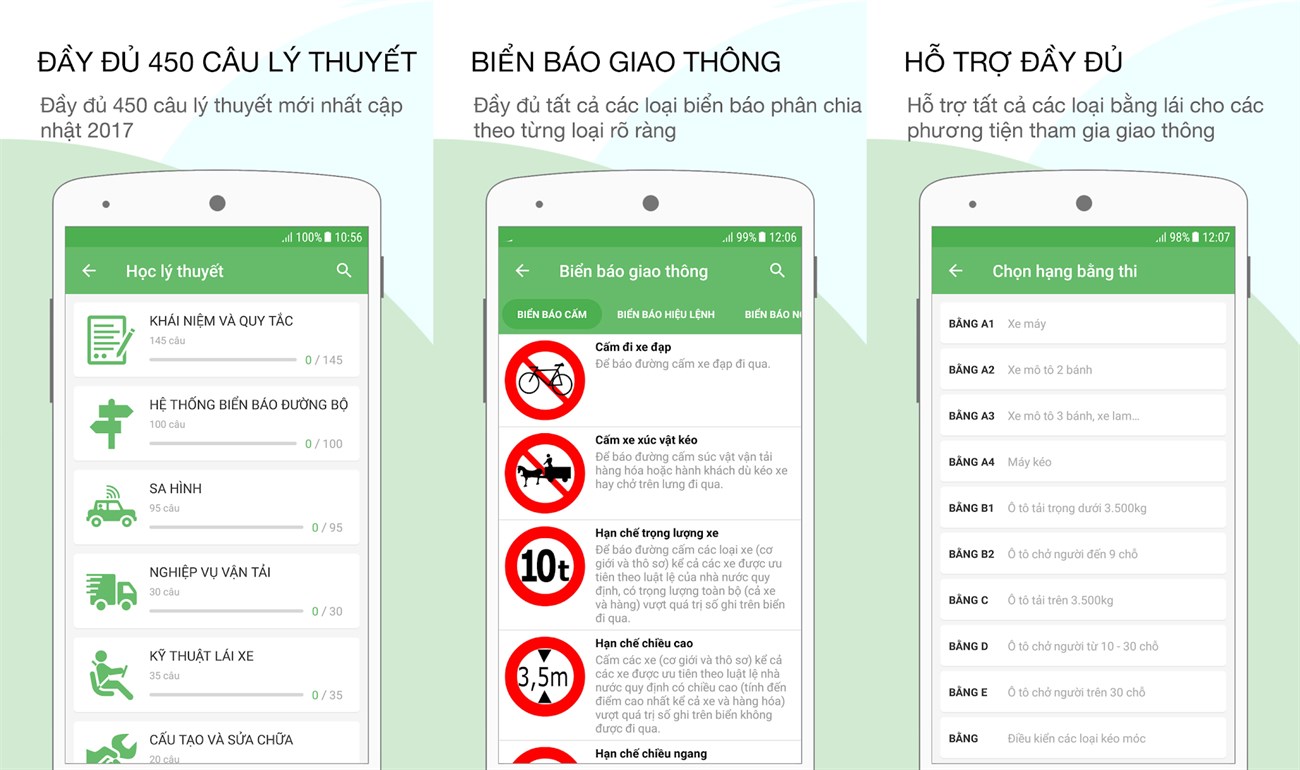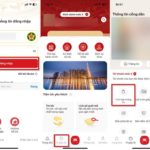Instructions for Downloading and Installing the Application
Our application is a free and convenient tool for individuals preparing for their driving tests. It is available for download on both CH Play and App Store.

Highlighted Features of the Application
The application covers a comprehensive set of 450 questions for the driving test, which include all types of motor vehicles (A1, A2, A3, A4, B1, B2, C, D, E, F).
- The questions are grouped clearly for easy navigation.
- Instant results are provided, accompanied with detailed explanations and tips for each question.
- You can review the questions you answered incorrectly to enhance your learning.
- A simulated test feature allows you to quickly assess if you would pass or fail based on precise test sets.
- A list of incorrectly answered questions is available for easy review of the theoretical part.
- A compilation of tips is provided to facilitate quick learning and memorization (not recommended).

In addition to the aforementioned features, our application also offers quick access to road traffic laws and related penalties:
- Road signs are classified and traffic laws are clearly explained.
- You can supplement your knowledge about road traffic laws in Vietnam.
- A list of all signs appearing in the question sets is provided for easy reference.

Car prices can also be obtained through our application:
- The latest car prices are regularly updated according to the market.
- Calculating the rolling cost when buying a car is supported.
Tips for Maximizing Your Learning Experience with the App
Studying all the questions can be challenging, especially for older individuals. To guide you in your study process, below is a suggested study schedule:
- Day 1: Spend 8 hours learning commonly seen signs. Focus on prohibitive signs, command signs, instruction signs, and warning signs.
- Day 2: Proceed to the study section containing 450 theoretical questions. Study and review these questions, along with the provided tips for each question. Pay attention to basic definitions such as alcohol concentration and permissible speed, and also learn the tips for answering maneuvering questions.
- Day 3: Go through all the test sets for each driving license class. After completing all the default sets (achieving 28 questions or more), choose 1 random set and continue practicing until your test scores consistently demonstrate competence. Congratulations, you have completed the study process.
Useful Tips for Answering the 450 Theoretical Driving Test Questions
1. Choose answers containing specific words:
- Prohibited or strictly prohibited
- Not allowed
- Comply
- Required
- Must have permission from the competent authority
- Lower gear, shift to gear 1
- Reduce speed (if there are 2 answer choices that reduce speed, choose the answer choice with the words right margin)
- Use rigid bar
- Temporary signal
- Signal from the traffic controller
- Railway vehicles
- Fire truck on duty
- Change the headlight from far beam to dipped beam
2. Prefer answers starting with the following words:
“Must,” “Observe,” “Check,” “Operate,” “Maintain,” “In,” “On,” “On top of,” “Fire truck”. In such cases, choose the longest answer.
3. Additional Notes:
- For questions with 2 answer choices (except for step 1), choose both options.
- For questions with 3 – 4 answer choices, read and understand each answer carefully.
4. For questions with the following words, choose 2 answers:
- Behavior
- Responsibility
- Duty
- Obligation
- Passengers
- Ethics
- Traffic culture
- Thought of Ho Chi Minh
- Participate in traffic
5. Tips for Speed Indicators: Apply the principle “8×7=56”
- 40km & 80km: Choose option 1
- 70km: Choose option 2
- 50km: Choose option 3
- 60km: Choose option 4
Note: The safe distance on the highway (middle number) is obtained by subtracting 30 from the largest speed.
6. Vehicle Speed within and outside Residential Areas
- Motorbikes: Apply rule 2 – 4 – 6 (2 wheels, 40km/h within residential areas, 60km/h outside residential areas).
- Mopeds: Apply rule 2 – 4 – 5 (similar to rule 2 – 4 – 6).
- Agricultural vehicles: Speed limit of 30km/h both within and outside residential areas.
7. Quick Selection Tips:
- Increase gear: Choose 1
- Reduce gear: Choose 2
- “Raise both hands”: Choose option 1 (applies to questions about traffic police raising one hand or both hands)
- “Raise one hand”: Choose option 2
- Early to late: Choose option 1 (within 1 day)
- Late to early: Choose option 2 (within 2 days)
- “Slope”: Choose option 1
- “High slope, long slope”: Choose option 2
- Diesel engine: No spark plugs
- Whenever “authority” is mentioned: Choose option 2
- FE: Choose answer 1
- FC: Choose answer 2
- Maximum age for driving with a class E license: 55 years old (male) & 50 years old (female)
- When asked about the age for taking the driving test, choose the oldest age
8. Knowledge to Remember: (corresponding answers will contain the following words)
- Transmission system: Ensures backward motion
- Seat belt: Must be securely fastened
- Windshield: Ensures safety
- Repairing carburetors: Involves using compressed air
- Luggage: Maximum weight of 20kg
- Distance to the nearest railroad: Maintain a distance of 5 meters
- There is a roundabout: Yield to the left, when no roundabout: Yield to the right
- The engine changes from inner to outer
- Thermal energy is converted into mechanical energy by the engine
- Turn signal distance: 30m for left/right turns
- Parking: Maintain a distance of 5 meters
- Signs and lights are effective on the left and behind the sign
- Transporting live animals: Requires loading for care and inspection (comply with quarantine and environmental protection regulations)
9. Questions about Alcohol Concentration:
- For cars and tractors: Drinking is not allowed
- For 2-wheel motorcycles and mopeds: Choose the highest alcohol concentration (0.25 or 50)
10. Vehicle Usage Period:
- Trucks: 25 years
- Transporting 9-seat or more vehicles: 20 years
11. Prescribed Capacity:
- Mopeds ≤ 50 cm3
- A1 ≤ 175 cm3
- A2 ≥ 175 cm3
- E > 30 seats
- FE: E + trailer (passenger car pulling wagons)
- FC: C + trailer (tractor, semi-trailer pulling semi-trailer)
12. Questions about Technical Features and Functions: (corresponding answers)
- Purpose of the power transmission system of cars: Used for transmission
- Purpose of the brake system: Used to reduce speed
- Purpose of the car engine: Converts thermal energy into mechanical energy
- Purpose of the car gearbox: Used for backward motion
- Purpose of the steering system: Used for steering
- Purpose of the clutch: Used for transmission or disengagement
- 2-stroke (2-cycle) engine, 4-stroke (4-cycle) engine
- Technical requirements for windshields: Safety glass
- Technical requirements for seat belts: Must be securely fastened
- Horn volume: Ranges from 90 to 115 dB
- When shifting to “drive” or “reverse” in an automatic transmission car: Fully press the brake pedal
- When making a U-turn: Turn the front of the car towards the danger
- Control shifting gears: Smoothly and accurately
- Conditions for cars to approach oncoming vehicles at night: Switch from dipped beam to high beam
- When releasing the handbrake: Pull the handbrake lever back while pressing the release button
- When starting a car on a level road: Completely release the clutch pedal
- Conditions for reducing gears in a car: Accelerate appropriately for the speed
- Conditions for driving a car on slippery roads: Avoid abrupt steering or sudden braking
13. Avoid selecting answers such as “both of the above” or “all are correct”
- Road traffic vehicles include 2 types: Motor and Non-motor
- Road users include: Motor and Non-motor vehicles + Special purpose motorcycles (e.g. bulldozers, cranes, etc.)
On roads with multiple lanes:
- Only change lanes where permitted.
- Non-motor vehicles travel on the far right side.
The above instructions provide guidance for studying the A1, B2 driving theory directly on your phone or tablet. If you have any questions or need further assistance, please leave your contact information below the article.



































